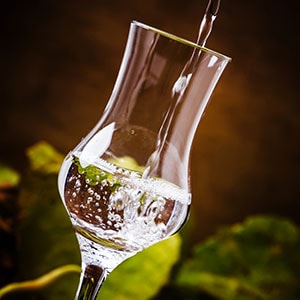The word "grappa" derives from the medieval Latin "grappolus" term by which the bunch of grapes was meant. It is not possible to establish a precise date that can sanction even the birth of a rudimentary distillate of marc; a first turning point was marked between the 19th and 20th centuries when the great Persian doctor, alchemist and philosopher Rhazes designed various parts of the distillation apparatus, one of which was the alembic. Later, the most famous scientist of Islam, Avicenna described in the chemical discipline the steam distillation system, a technique later used for the production of alcohol and essential oils.

The Arab alchemical tradition was handed down to medieval European science; it was the Salerno Higher Institute of Sciences that regulated the techniques for the production of brandy, but only for medicinal use. The precious technique spread quickly especially in monasteries, where Dr. Albert the Great (1193-1280) in some of his writings spoke of a very light water, obtained from wine, able to float on olive oil (a 'aqua ardens).
Also in the Vatican Consilia codex of 1276 there are detailed citations of the double distillation of wine to produce brandy (Taddeo Alderotti di Firenze 1215-1302). It is therefore possible to trace the birth of grappa back to the period between 1300 and 1400 when the first water cooling system was applied to stills.
However, the popularity of the pomace distillate came with Giovanni Michele Savonarola (Padua 1385 - Ferrara 1468); he was a great Italian physician, humanist and scientist who in his writing the "De Conficienda Aqua Vitae" planned and analyzed in detail a real industrial process for distillation. of wine brandy in Germany and the East, where it was highly used to combat plague and gout.
At the base of this distillate we find centuries of history and peasant activities where grappa was essential for the economy of poor rural families. Initially it was intended for the less well-to-do, the poorer classes, being a raw liquid not at all refined, strong and unpleasant; it served to not feel hunger, cold and fear. It was a product derived from the waste obtained from the production of wines destined for the wealthiest, the nobles (the stalks, the skins, and the seeds of fermented and squeezed grapes).
New in-depth studies on pomace as a source of alcohol were later carried out by two Jesuits, the German Athanasius Kircher (Geisa 1602 - Rome 1680), and his pupil Francesco Lana de Terzi (Brescia 1631 - Brescia 1687).
In 1700 the first specific distillation columns for marc were built which would make production more economical. In 1870 the tax on the manufacture of spirits was applied, while it was in 1888 that family distillation was allowed for a maximum production of 50 liters per year.
The term grappa, already in use for a long time in the common language, enters the Italian vocabulary at the beginning of the 1900s. for a long time under master. Being very fond of mechanics, he later decided to set up his own business, and built special stills for discontinuous distillation in a bain-marie with rectification columns with plates. Special plants all rigorously in copper that revolutionized the sector, changing the world of grappa forever.
The latter, during the Great War, was provided to the Alpine troops in order to give them the strength and courage to face the conflict in its innumerable difficulties. After the Second World War, Italian society changed its lifestyle; the brandy produced with waste marc, also known as contraband alcohol or the spirit of courage and comfort for the soldiers at the front, becomes less aggressive and more drinkable. A long time has therefore passed since grappa, especially in Friuli and Trentino, was characterized by a strong, alpine, mountainous and rustic character.
Today the master distiller carries on the values of tradition in order to create true masterpieces, capable of seducing the most attentive consumers. A method through which with wisdom they will know how to separate, or "cut", the precious "heart", from the "head" to the "tail".
Currently the grappa produced is a soft, less aggressive, aromatic and / or aged distillate. According to the EU law of 2008, the term "grappa" is a protected geographical denomination and can only be called the pomace brandy made from grapes produced, vinified and distilled exclusively in Italy or in Italian Switzerland.
Each territory produces grappa according to its tradition and culture; this makes each grappa different from the other, offering the taster the opportunity to explore a great variety of the Italian distillate par excellence.
Visit our selection dedicated to the best
jokes.













 Include a free greeting card by writing your message in the dedicated field at Checkout
Include a free greeting card by writing your message in the dedicated field at Checkout





